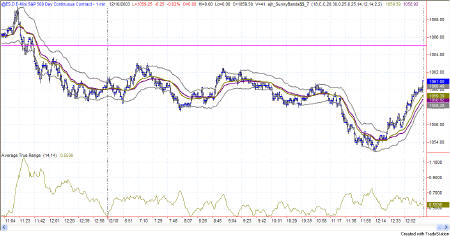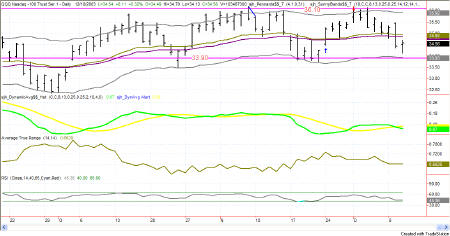The Sunny Side of the Street
TECHNICAL ANALYSIS EDUCATION: EXPLAINED AND DECIPHERED FOR NEW AND
VETERAN TECHNICAL ANALYSTS ALIKE.
WEDNESDAY EVENING -
Dec 10, 2003
Archives of Past
Commentaries . How Did We Do?
Weekend Stock Picks --
CLICK HERE
| Anyone interested in posting comments or questions to the bulletin board may click here. Sunny personally answers each question or comment posted. | ||
$60,399 in Stock Picks to date! Click Here to view.
Another sideways day. An up day, a down day and a sideways day.
That's how it seems to be going. That's, of course, the sideways
formation of the 4th wave, as I have said over the past several weeks.
SIdeways correction, because the 2 wave was steep.
Looking at FIgure 2 and 3, you can see the correspondence between the EMini and the QQQ is still true to form, again with the QQQ leading just a bit. Today's QQQ was definitely a sideways, narrow channel that got broken at one point, but the final result was still, open to close, virtually a sideways day.

Figure 2: QQQ 1 minute intraday
On the daily charts, a more true story is told. Looking at Figure 4 and 1, you can see that intraday prices were reaching down to try and touch the lower Attractors. This is especially evident in FIgure 4. One more day like today, reaching lower intraday and touching the Attractor, and the current correction could be over. Then we expect a bounce to occur.

Figure 3: EMini 1 minute intraday
This little cycle, which you can see in Figure 4, is shorter in duration than those preceding them. The moves are move direct and to the point. It could culminate with a bit more sideways motion, but I don't think so. This market is so biased to the upside that I think after price touches 33.90 on the QQQ, and 1060 on the EMini we will resume the up moving business.
Lots, and lots of my competitors (other newsletter authors and editors) are in disagreement with me. The crowd is saying we are in for a big correction. I don't think so. Again, I think sideways is the direction de jour. Resuming the upside activity will likely result in another up and down cycle, so beware.
RSI is almost low enough for the bounce to occur, but I don't expect a huge move out of it because RSI has been wavering slowly between 40 and 65, but going no further up for so long. Until RSI goes above 65, we are still in a sideways market.
Don't bet the farm, but keep your speculating small and cautious. This is not an investors market, and not the time to be throwing everything you have at the market. Small moves are in favor for intraday and daily charts, with progress happening rather slowly and over time.
Keep your senses about you and use strict discipline in trading.
Trading is a risky business.
Attractor: a level to which prices seem to be drawn, like a magnet. Usually these are lines of support or resistance from previous highs and lows, but can also be an important level on an indicator, or the edge of a Sunny_Band.
PHW: Potential Hourly Wage. A term coined by Sunny to examine whether trading for a living is really worth it when compared to the minimum wage standard. Before considering a trading system to be a success, it should pass the PHW test.
RSI: Relative Strength Index (TradeStation function)
SDMA: Sunny's Dynamic Moving Average (proprietary)
Shooting Star: A candlestick pattern discussed further under Reference, Candlesticks.
SDMA_Hst: Sunny's Dynamic Moving Average presented in a histogram format where the line representing the difference between the two SDMA lines turns from red to green when the two SDMA lines cross each other (the difference is zero). The yellow line is an average of the histogram line.
Sunny_Band: Sunny's Dynamic Moving Average plus 1.5 ATR and minus 1.5 ATR, creating a band on either side of the SDMA.
Vehicles: Trading symbols. IBM is an equity vehicle; SPU03 is the SP futures contract that expires in Sept of 2003; @ES.D is the EMini; mutual funds are vehicles; gold is a trading vehicle; etc.
This commentary is meant only for EDUCATIONAL PURPOSES. It is to help you see how a Technical Analyst reads the signs in the markets.
Stay sharp and on your toes. Moves can reverse on a dime, anytime. Let the market speak to you. If the market is going down, by golly ignore my commentary from the night before and know that the market is going down.
RULES OF THUMB:
0. I keep the chart in Figure 1a on each day's commentary simply to illustrate how much in tandem the 4 indexes I watch actually are. For this reason, I don't always comment on every index. Analysis of one speaks highly for the same analysis for each of the other indexes.
1. When price is pushing the upper Sunny_Bands upward and then eases off and moves back toward the midline, it's time to take profits. If it starts moving up and pushing on the Sunny_Bands again, it's time to get back in. Likewise, if the market is pushing down on the lower Sunny_Band and eases off to move back to the midline, it's time to take profits from the short play.
2. Divergence of the RSI and price is another good time to take profits and wait for a breakout of price before taking a position.
3. When the exchange puts in curbs or trading halts on a large move down, it usually (not always) stops the downward motion. After the market reopens is a good time to take profits from your short position.
4. The market can't go nowhere forever. Eventually, who knows how long it will be, there will have to be a breakout-- one direction or the other.
5. This commentary is for educational purposes only, and is meant only to teach readers about my indicators, other technical indicators, and how I read them.
==<:>==
While it may be true that a picture is worth a thousand words, it is definitely not true that a picture deserves a thousand words.

